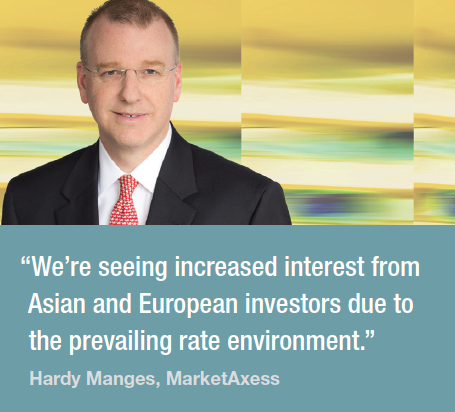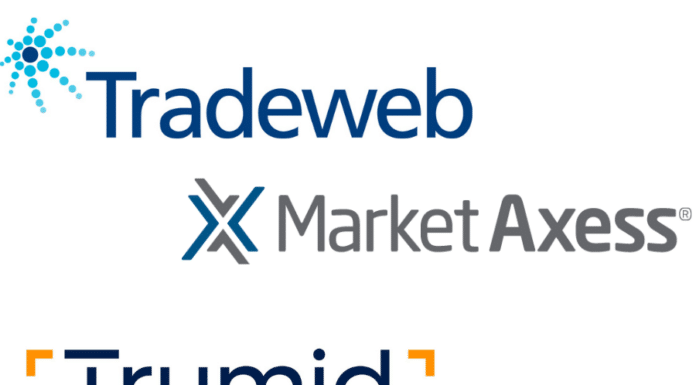GLOBAL WINDS OF CHANGE FUEL MUNICIPAL BOND AUTOMATION.
International interest is pushing the municipal bond market towards greater electronification and transparency. Chris Hall reports.
A new era dawned in the US municipal bond market in August, when the Upper Mohawk Valley Regional Water Finance Authority became the first US issuer to receive a green bond assessment from Moody’s. Although the New York state utility may only serve 130,000 residents, its new GB1 label means US$8.78 million of its water system bonds will be recognised internationally as achieving the gold standard of green investments.But international interest in and influence on the US$3.7 trillion ‘muni’ market is growing in a number of ways, despite its resolutely domestic characteristics, entrenched by a diverse range of issuers, a dizzying array of security types and substantial retail investor base. Moreover, creeping internationalisation is opening doors for electronic trading venues and platform providers hoping to ease the challenge of sourcing securities in an often illiquid ‘buy-and-hold’ market.
 Many believe the market is overdue an overhaul, including Luis Aguilar, a former commissioner at the US Securities and Exchange Commission. In February 2015, shortly before the end of his term in office, Aguilar described the muni market as “excessively opaque, illiquid, and decentralised”, handing out “second-class treatment” to retail investors. Acknowledging that its diversity posed unique difficulties, Aguilar nevertheless insisted the costs heaped on issuers and investors by the muni market’s lack of liquidity and transparency were unsustainable, observing: “It is particularly dismaying to realise that it is currently twice as expensive to trade New York municipal bonds as it was in the 1920s.”
Many believe the market is overdue an overhaul, including Luis Aguilar, a former commissioner at the US Securities and Exchange Commission. In February 2015, shortly before the end of his term in office, Aguilar described the muni market as “excessively opaque, illiquid, and decentralised”, handing out “second-class treatment” to retail investors. Acknowledging that its diversity posed unique difficulties, Aguilar nevertheless insisted the costs heaped on issuers and investors by the muni market’s lack of liquidity and transparency were unsustainable, observing: “It is particularly dismaying to realise that it is currently twice as expensive to trade New York municipal bonds as it was in the 1920s.”
Despite these shortcomings, the market is currently experiencing strong inflows from a broad range of investors – domestic and overseas. In parallel, international regulatory trends are providing new liquidity challenges and imposing new execution requirements. Three global themes in particular are making their presence felt.
First, munis are in extremely high demand. The extended period of low interest rates around the world is making muni yields attractive to an ever-wider range of investors, as is their imperviousness to uncertainties over US monetary policy compared with other fixed-income instruments. In July, munis marked their 43rd straight week of inflows, representing US$51 billion in total, with the S&P Municipal Bond Index registering a healthy year-to-date return of 4.37%. With deposit rates in negative territory, muni’s mix of respectable returns, strong credit quality and low volatility are winning a global fan base, many of whom are unfamiliar with the market’s idiosyncrasies and ineligible for its tax benefits.
 “We’re seeing increased interest from Asian and European investors due to the prevailing rate environment,” says Hardy Manges, head of dealer sales, for municipal bonds, at electronic platform operator MarketAxess. “Typically, these new investors prefer to access the muni market electronically, rather than trying to reach a New York trading desk by phone.”
“We’re seeing increased interest from Asian and European investors due to the prevailing rate environment,” says Hardy Manges, head of dealer sales, for municipal bonds, at electronic platform operator MarketAxess. “Typically, these new investors prefer to access the muni market electronically, rather than trying to reach a New York trading desk by phone.”
Sell-side interest is still muted as a result of the second global wave re-shaping munis and other fixed-income markets: tighter post-crisis capital rules. The global roll-out of the Basel III capital adequacy framework has seen major sell-side firms slash their fixed-income inventory and their appetite for principal-based trading, leaving investors seeking alternative liquidity providers.
TABB Group global head of research and consulting Anthony Perrotta says the impact of Basel is being felt directly on sell-side trading desks. “Immediacy is in sharp decline and hence, principal-based trading and turnover periods are shorter. Holding aged inventory is more punitive, therefore dealers are reluctant to bid on more difficult trading opportunities which may require a more lengthy distribution cycle,” he says. “This may cause market participants to try and utilise electronic mechanisms as a means to make pre-trade discovery more efficient and to scale distribution.”
There is also uncertainty over whether and which munis will be included in the definition of high quality liquid assets used to calculate US banks’ liquidity coverage ratios under the Basel guidelines. Bonds not included will be more expensive to hold on balance sheet, with the result that dealers “may become hesitant to provide liquidity in the secondary market, increasing liquidity risk for municipal bond holders,” according to Fitch Ratings.
Thirdly, the global regulatory requirement for more transparent demonstration of best execution is increasingly a fact of US trading life. On a worldwide basis, buy- and sell-side firms are under greater pressure to prove they’ve sourced the best available deal for end-investors and muni-market intermediaries are no exception. In Q4 2015, the Financial Industry Regulatory Authority and the Municipal Securities Rulemaking Board issued guidance emphasising the obligation of intermediaries to establish and enforce effective processes and procedures to deliver best execution, including documentation of efforts to achieve optimal pricing.
 “The new best execution requirements being introduced into the muni market – which require firms trading on behalf of retail investors to implement rigorous price discovery processes – will create new business opportunities for electronic platforms,” says Michael Decker, managing director and co-head of municipal securities at the Securities Industry and Financial Markets Association (SIFMA).
“The new best execution requirements being introduced into the muni market – which require firms trading on behalf of retail investors to implement rigorous price discovery processes – will create new business opportunities for electronic platforms,” says Michael Decker, managing director and co-head of municipal securities at the Securities Industry and Financial Markets Association (SIFMA).
Though traditionally voice-broked, the muni market is hardly devoid of automation, with electronic platforms already helping to facilitate order flow and price discovery in the client-to-dealer and dealer-to-client markets. A new wave of electronic platforms are bringing new trading protocols from other institutional markets, most notably MarketAxess’s introduction of its ‘all-to-all’ Open Trading platform to the muni market, unveiled in March. MarketAxess was one of 19 firms included in SIFMA’s survey of electronic trading platform providers in the US corporate and municipal bond markets in February, many of which were new or prospective entrants. There is markedly more activity in the corporate than municipal markets, but there is the very real prospect of new protocols – including dark pools and session-based trading – taking root as the municipal bond market evolves in response to new global and local realities.
But are the new platforms getting ahead of themselves? Are the muni markets’ problems overblown or proposed remedies mis-diagnosed? Record inflows are certainly masking structural problems at the more liquid end of the market. “Liquidity is very good,” asserts Sean Carney, head of municipals strategy at BlackRock. “Participants can get in and out of the market with ease and bid/ask spreads are tight.”
While acknowledging that muni investors could benefit from technology innovation that can deliver improved market intelligence – through more sophisticated analytics and portfolio management tools – some incumbent platform providers suggest new trading models will only take off when fundamental changes are made to the primary market.
“For micro lots of below 100 bonds – for example regional broker-dealers trading on behalf of clients in the securities of local issuers – the market is already pretty efficiently served by mature platforms. For odd and round lots above 100 bonds, there are considerably fewer market participants and much greater liquidity in bigger issues. This market is dominated by the bulge-bracket firms that are willing and able to commit capital to the market in support of their primary issuance franchises,” says John Cahalane, head of Tradeweb Direct, which combines Tradeweb’s retail services with its recent BondDesk purchase. “Trading in these issues is so tightly bound to underwriting that much of the trading activity is still conducted over the phone.”
Nevertheless a switch toward institutional investment away from retail ownership may lead to greater eletronification. Tax benefits and steady returns have made munis a retail staple, but a report entitled ‘Who holds Muncipal Bonds?’ published by Wells Fargo research in Q3 2015 estimates individual holdings, as opposed to investment via mutual funds, have fallen by a quarter since 2011, partly in response to default concerns from Puerto Rico to Detroit. With the slack being picked up by institutional investors and asset managers – foreign and domestic, environmentally-conscious or purely profit-driven – munis may develop more wholesale market characteristics sooner rather than later.
©TheDESK 2016
©Markets Media Europe 2025










